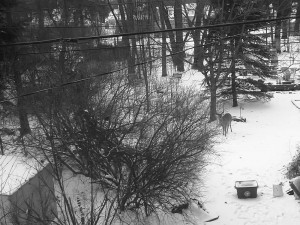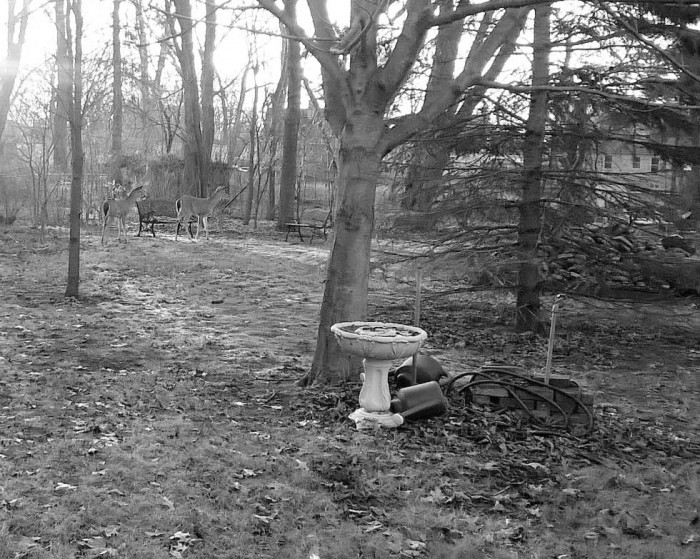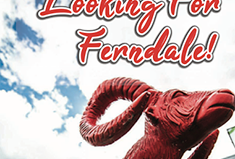Deerly Beloved.. Opposing Views on Feeding The Deer
…we are gathered here today to debate a matter of human vs. nature. Despite its urban setting, you may have noticed deer appearing more frequently in the Ferndale Friends reading area.They may have even popped up in your own yard. The question is, which is better; to feed the deer, or not? Are we helping our animal friends, much as we would wild birds, or are we creating a new nuisance animal and a hazard? Here to debate the issue are two experts on the subject, on opposite sides of the fence: Robert Primeau and Trish Marie.
 Robert: My name is Robert Primeau and I’m a 32 year old landscape designer for the U.S. Fish and Wildlife Service, where I am currently working on the design and management of infrastructure and restoration projects at the Detroit River International Wildlife Refuge, located largely in Downriver and the only multinational Refuge on the continent. I also have experience in open space preservation development, air monitoring, and wetland science. I was born and raised in Downriver but have counted Ferndale my home since 2012. I love sci-fi, standup comedy and I garden way too much.
Robert: My name is Robert Primeau and I’m a 32 year old landscape designer for the U.S. Fish and Wildlife Service, where I am currently working on the design and management of infrastructure and restoration projects at the Detroit River International Wildlife Refuge, located largely in Downriver and the only multinational Refuge on the continent. I also have experience in open space preservation development, air monitoring, and wetland science. I was born and raised in Downriver but have counted Ferndale my home since 2012. I love sci-fi, standup comedy and I garden way too much.
Trish Marie: I am a 56-year-old lifelong amateur naturalist, avid (a better word would be voracious) reader – much of that primarily nonfiction, ecology, biology, natural history, (etc) related. I’ve lived on the same semi-rural tenacre parcel of property over 30 years, watching and supplement feeding the wildlife here the entire time. Married (over 30 yrs), one adult daughter (who was born on Earth Day).
Robert: I am against the feeding and welcoming of deer in Ferndale and other urban communities because their presence is incompatible with the environment we, as humans, have created. Deer are a robust “edge” species, and given a steady food supply will reproduce quickly, with each female eventually producing twins annually. With no predators in urban environments except for automobiles, deer numbers will always eventually reach nuisance levels. With more deer comes the destruction of landscaping and gardens and increased risk of car accidents on our busy roads. A subset of deer enthusiasts should not be allowed to make that decision for everyone.
Trish: People have confiscated so much of the natural landscape that wild creatures are left to live in ever diminishing “islands.” Where I live, yards are an acre or larger, yet owners keep these mowed edge-to-edge. Besides the “biological desert” effect of a mowed yard, many “landscape” favorites used are non-natives of little to no use to wildlife (If I never see another newly planted “Bradford Pear” I’ll die happy!). It seems only just to replace some of what we’ve taken–deer after all can’t go to the grocery store and buy food grown thousands of miles away. Helping wildlife also teaches children compassion and environmental stewardship, both greatly needed qualities in today’s world!
Robert: As habitat loss from development, resource extraction, and climate change builds and threatens our planet, the drive to cultivate compassion and stewardship towards wildlife is more critical than ever. However, such actions are not always appropriate to their current environment.
Unlike how deer were portrayed in Bambi or other media, deer are not animals of the forestprimeval. They are most abundant in disturbed habitats where a lush and weedy undergrowth is prevalent. The only reason the upper peninsula, for example, is so thick with deer is because it is a collection of tree plantations and relatively young forests (less than a century old) due to it all being logged out a century ago. My point is that the suburbs are such a disturbed habitat and in such an environment a deer, all looks aside, is functionally similar to a rat. It eats a wide variety of undergrowth and landscaping plants and reproduce prolifically. Unlike a rat, you will notice it if you hit one with your car on a busy street like Woodward Heights or Pinecrest, not to speak of 8 Mile or Woodward.
Compassion is critical but so is respect. I would argue that having respect for an animal also means respecting it’s life history. That includes both being responsive to what deer are capable of if we give them an inch, and what it takes to maintain a dense human habitation once you have sliced it into tiny parcels and intercut it with busy roads.
Trish: Yes, like any species deer (including humans) deer numbers can grow to the point where they threaten the integrity of their own environment. That said, supplemental feeding of deer does not drive overpopulation. Any deer that are dependent upon supplemental feeding to survive the winter, and even more so, to drive population increase are being over-artificially fed! I’m all for supplemental feeding of wildlife, but it must be done properly. (For instance, corn is a very bad winter food for deer–though I’ve seen even self-professed “sportsmen” put corn out. Deers’ digestive systems shift from summer to winter; in winter their digestion is geared towards high roughage, low nutrient foods. Corn is insanely high in sugar. Feeding corn to winter deer can upset their digestion and even kill them. Safer foods are in-shell oil sunflower and oats, in small quantities).
The primary driver of deer overpopulation in this state is the DNR. Although the DNR is tasked with managing wildlife for all of the state’s residents, not just the tiny fraction who hunt (hunters stand at less than 10 per cent of the population), what the DNR does instead is caters to that 10 per cent to the point where they are essentially running a state-sized deer farm. (This is the result of the Pittman-Robertson Act, which even many avid hunters have said is a “good idea gone bad,” which has “essentially served to undo progressive wildlife management” by directing resources and effort towards species that hunters love to hunt while leaving the integrity of the entire environment wanting…the quotes are from Dennis Fijalkowski of MUCC).
Putting out appropriate foods in small quantities not only helps those who’d rather watch deer than kill them, but helps the deer get through sometimes rough patches, and certainly makes their life more comfortable. But it does not create more deer. What creates more deer is all of the resources our state throws at …well, producing more deer!
If something happened with our health, we believe there is a solution to any maladies in a preparation. What medicines do patients purchase online? Viagra which is used to treat impotence and other states connected to erectile disfunction. Learn more about “sildenafil“. What people talk about “viagra stories“? The most essential aspect you must look for is “sildenafil citrate“. Such problems commonly signal other problems: low libido or erectile disfunction can be the symptom a strong soundness problem such as heart trouble. Causes of sexual disfunction switch on injury to the penis. Chronic disease, several medicaments, and a condition called Peyronie’s disease can also cause sexual dysfunction. Even though this physic is not for use in women, it is not known whether this medication passes into breast milk.



